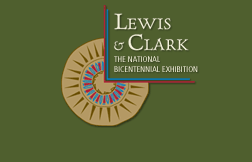
 |
The accompanying multi-disciplinary curriculum also asks these questions. Designed for grades four through twelve, it is divided into units that follow the major thematic sections of the exhibition. These themes tell the story of the expedition through an approach that encourages students to examine multiple perspectives and use a variety of historical sources, one that seeks to allow the voices of the past and present to speak for themselves. Most themes focus on the expedition's interaction with one particular Indian culture, though a variety of Indian cultures are represented throughout the materials.
The units were designed by teachers for teachers. They follow a "backwards design" format that includes an enduring understanding, essential questions, lessons, and a culminating performance assessment. Units are linked to Missouri state standards and National Council for the Social Studies and National Science Teachers Association standards. The lessons are inquiry-based and use many of the most interesting documents, artifacts and Indian interviews featured in Lewis & Clark: The National Bicentennial Exhibition.
What About York?
Two essential books provide background information on the expedition's encounter with Indian cultures and are recommended reading for teachers who plan to use these materials. Carolyn Gilman, Lewis and Clark: Across the Divide. Washington, D.C.: Smithsonian Books, 2003. James P. Ronda, Lewis and Clark among the Indians. Lincoln and London: University of Nebraska Press, 1998.
Lewis and Clark used a range of instruments and skills in their journey of exploration, and today's learners also need to work nimbly with different types of evidence. The curriculum incorporates a variety of teaching formats and allows for a great deal of flexibility in the classroom. The units range in length from three to six lessons. Because lessons encourage analysis of historical sources, the following standards apply:
Encounters with original documents are an exciting way for students to make contact with the past. In this curriculum, images of original documents are available with the lesson whenever possible, and a transcript is provided along with the image. In the case of entries from the Lewis and Clark journals, only transcripts are provided, but these have rarely been modified to fit the common language standardizations of today. Clark is especially notorious for his creative approach to the English language and any good historian must face the challenges of nonstandard syntax, spelling, and usage. It will be important to clarify for students that the language was not standardized until later in the nineteenth century and remains, to an extent, in flux.
Past and present are joined in the fascinating oral traditions of American Indians. The lessons incorporate recollections and commentary from Indians themselves. In some cases these are previously published oral accounts. In other cases, contemporary people offer their perspectives. Many of these present-day interviews are presented in the form of short video clips. All have an accompanying transcript.
Small or large, beautiful or homely, artifacts from the past have rich stories to tell that can be found in no other way. There are challenges in analyzing a three-dimensional object through a two-dimensional computer screen. However, in many cases the images can be enlarged for closer examination. Object-based lessons offer the teacher several options: printing the object image to a transparency for use on an overhead projector, projecting the computer screen onto a large screen, using a computer lab where individuals or pairs of students can examine the objects online, or printing out the image for classroom use.
Lewis and Clark did not leave St. Louis without them, and today's explorers will need maps, too. All maps featured in the lessons can be enlarged for closer study.
This CD-ROM includes a virtual exhibition component. The nine curriculum themes each have a corresponding virtual exhibit that provides important contextual material. In addition, a map-based virtual journey highlighting the expedition route is available online at www.lewisandclarkexhibit.org. Both virtual components allow for deeper exploration of the themes presented in the curriculum units.
A Connections to Today page is linked to each curriculum unit and includes a short interview with a person who readily illustrates the unit's connection to contemporary events and issues. These pages are designed to help students connect the Lewis and Clark expedition with the present. For example, Dr. Marc Susser, historian of the U.S. Department of State, talks about the challenges of diplomacy in today's world — an obvious connection to the Politics and Diplomacy curriculum unit.
A dedicated Image Gallery appears with each lesson. Online, the Galleries include information on these primary sources to aid teachers in lesson preparation. By downloading an Image Gallery in either Windows or Macintosh format, teachers may use the material in the classroom. A password provides teacher-only control of images and their information, encouraging students to perform initial analysis free of identification and background material. This download option is only available on the website.
To view some materials in the curriculum units, you will need to have the free Macromedia Flash and Adobe Acrobat plug-ins.
Click here to read the copyright and reproduction policies for these materials.
Do you have comments on these materials? Let us know. We can be reached at edcenter@mohistory.org.
|
|||||||||||||||||||||||||||||||||||||||||||
 |
 |
 |
 |

